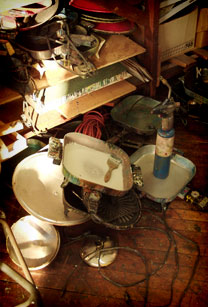
Equipment
Encaustic Paint
Encaustic is a beeswax based paint typically composed of wax, resin, and pigment. It is kept molten on a heated palette and applied to a surface where it is reheated in order to fuse the paint into a uniform enamel-like finish.
Encaustic is as beautiful and as versatile as any 20th century medium. It can be polished to a high gloss, molded, sculpted, and combined with collage materials. It is the most durable of artist’s paint materials, as beeswax is impervious to moisture. Its unique components lend themselves to the artists imagination and creativity.
Encaustic painting was practiced by Greek artists as far back as the 5th century B.C. The word encaustic comes from the Greek and means to burn in, which refers to the process of fusing the paint. The Roman historian Pliny wrote about encaustic in the 1st century A.D., noting its use in portraits and scenes of mythology, also for the coloring of marble and terra cotta. The best known of all encaustic work are the Fayum funeral portraits painted in the 1st and 2nd centuries A.D. by Greek painters in Egypt. These were portraits of the deceased placed over the person’s mummy as a memorial.
Encaustic became a lost art after the 12th century, as the process was cumbersome and painstaking, and the cost of producing it was high.
A resurgence in the 20th century, due to portable electric heating implements and a variety of tools, is seeing encaustic painting once again taking its place as a major artists’ medium. Ralph Mayer in his The Artists Handbook states “It’s effects, its visual and physical properties, and its range of textural and color possibilities make it eminently suitable for use in several different contemporary styles of painting that are not adequately served by our traditional oil-painting process.”